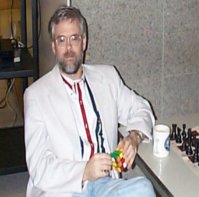
Mathematics of the Rubik's cube
These notes cover enough group theory and graph theory to understand the mathematical description of the Rubik's cube and several other related puzzles.
Tag(s): Mathematics
Publication date: 31 Dec 1996
ISBN-10: n/a
ISBN-13: n/a
Paperback: 281 pages
Views: 27,505
Type: N/A
Publisher: n/a
License: n/a
Post time: 28 Mar 2007 10:31:13
Mathematics of the Rubik's cube
 These notes cover enough group theory and graph theory to understand the mathematical description of the Rubik's cube and several other related puzzles.
These notes cover enough group theory and graph theory to understand the mathematical description of the Rubik's cube and several other related puzzles.
Publication date: 31 Dec 1996
ISBN-10: n/a
ISBN-13: n/a
Paperback: 281 pages
Views: 27,505
Document Type: N/A
Publisher: n/a
License: n/a
Post time: 28 Mar 2007 10:31:13
Groups measure symmetry. No where is this more evident than in the study of symmetry in 2- and 3-dimensional geometric figures. Symmetry, and hence groups, play a key role in the study of crystallography, elementary particle physics, coding theory, and the Rubik' s cube, to name just a few.
This is a book biased towards group theory not the "the cube". To paraphrase the German mathematician David Hilbert, the art of doing group theory is to pick a good example to learn from. The Rubik's cube will be our example. We motivate the study of groups by creating a group-theoretical model of Rubik's cube-like puzzles. Although some solution strategies are discussed (for the Rubik's cube - the 3 x 3 x 3 and 4 x 4 x 4 versions, the "Rubik tetrahedron" or pyraminx, the the "Rubik dodecahedron", or megaminx, the skewb, square 1, the masterball, and the equator puzzle), these are viewed more abstractly than most other books on the subject. We regard a solution strategy merely as a not-too-inefficient algorithm for producing all the elements in the associated group of moves.
The approach here is different than some other group theory presentations (such as Rotman [R]) in that
(a) we stress puzzle-related examples over general theory,
(b) we present some of the basic notions algorithmically (as in [Bu]), and
(c) we tried to keep the level as low as possible for as long as possible (though only the reader can judge if we've keep it low enough long enough or too low too long).
The hope is that by following along and doing as many of the exercises as possible the reader will have fun learning about how groups occur in this area of recreational mathematics. Along the way, we shall also explain the rules of a two person game (the Gordon game) which arises from group theory - a game which arises from a group not a group which arise from a game. See also the superflip game introduced in §4.6 and the Icosian game in §6.2.1.
Tweet
About The Author(s)
W. David Joyner is a professor in the Department of Mathematics at The United States Naval Academy. He received his Ph.D. in Mathematics at the University of Maryland in May 1983. His research areas are error-correcting codes, representation theory and applications, and applications of number theory/group theory to communication theory and cryptography.

W. David Joyner is a professor in the Department of Mathematics at The United States Naval Academy. He received his Ph.D. in Mathematics at the University of Maryland in May 1983. His research areas are error-correcting codes, representation theory and applications, and applications of number theory/group theory to communication theory and cryptography.